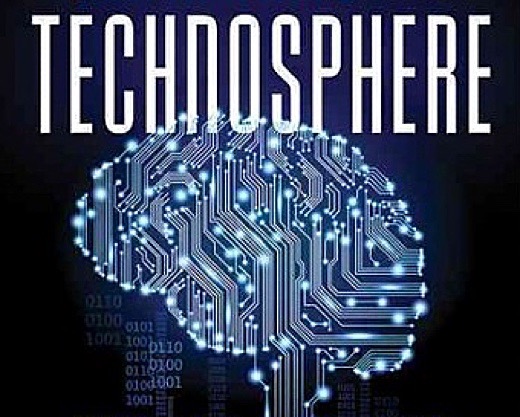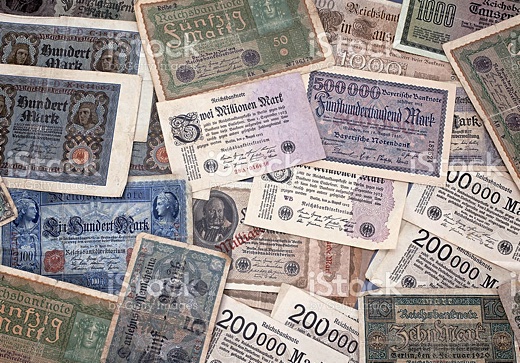SUBHEAD: Getting a grip on technologies that limit our autonomy, self-sufficiency and freedom.
By Frank Kaminski on 25 December 2017 for Mud City Press -
(http://mudcitypress.com/technosphere.php)

Image above: Detail of cover ogf "Shrinking the Technosphere" by Dmitry Orlov. From original article.
When the average person thinks about technology, the first thing that comes to mind isn't a family dog or cat. Nor would one likely consider a flock of chickens, a packet of seeds or a sack of potatoes to be examples of technology.
But technology thinker Dmitry Orlov, in his book Shrinking the Technosphere, argues that that's exactly what they are.
In the context of a rural homestead, a dog is a highly advanced home security system, cats and chickens are a pest control service (the former targeting rodents and the latter insects) and potatoes and seed packets play an indispensable role in meeting the dietary and medicinal needs for which city dwellers are dependent on factory farms and pharmaceutical plants.
These are all instances of "naturelike" technologies, or those that represent, in Orlov's words, "human adaptations of things nature has produced as evolved traits in other species."
Orlov's book advocates a shift toward these types of technologies and away from the destructive, doomed technologies that currently define our lives in the developed world.
Such a change is necessary because of the unsustainability of today's dominant technologies. The Earth's technosphere exists in a trap in which it must either grow or die, and to grow it needs ever-greater quantities of natural resources.
But we're now in an era in which many of these resources—from oil to minerals to the lithium needed to make computer and electric car batteries—are at, near or past their peak production rates. In addition to resources, the technosphere needs environmental sinks in which to dump its wastes, and these too are coming up short.
Consequently, concludes Orlov, the technosphere is destined to collapse, and our best course of action is to whittle it down to the point where its fall won't impact us more grievously than it has to.
Easily Orlov's most profound work yet, this book covers an astonishing amount of territory, and it does so with Orlov's usual winning combination of scholarly research, sly wit and practical, tested, real-world wisdom.
The present review endeavors to explore some of its key points; but rest assured that, as involved as my assessment might seem, it captures only broad strokes. For the full story, I strongly recommend that you buy the book.
Shrinking the Technosphere begins by contesting some deeply held, seldom-questioned beliefs about technology. It's commonly assumed that modern machines allow us to work more efficiently than in the past, that more of them is always better, that new innovations are invariably superior to what they replace and that technology in general holds the key to solving any problem we may face.
Yet, as Orlov shows, the evidence doesn't support these assertions. The supposed efficiencies and beneficence of today's advanced industrial technologies disappear when one takes negative externalities into account.
Orlov counters the claim that modern tools and methods are more efficient than manual labor by pointing out that the opposite appears to be true.
Far from delivering us to some promised land of ultimate leisure and fulfillment, our gadgets have caused us to lead increasingly hectic lives, due to the need to earn more and more money to pay for them all.
What often turns out to be most efficient is doing without a supposedly time-saving device. As for the belief that more technology is always better, Orlov observes that Earth's oceans (to take one example out of many that he cites) would beg to differ.
Overfishing, pollution and absorption of excess CO2 that we're pumping into the atmosphere are driving the seas toward a primordial state hospitable only to microbes and jellyfish.
For the oceans, less of our technology would definitely be better. And the insistence that technology can solve any problem is contradicted by the many crises from which technology offers us no prospect of salvation, since it's technological development itself that's causing them.
In light of these points, the argument this book makes for bringing our technology choices back under control is as sensible as it is impassioned.
An engineer by training, Orlov proposes a systematic program for reducing our dependence on the technosphere one piece of technology at a time. His methodology includes a set of rather simple equations that readers can use in vetting all the technologies in their lives based on their relative ratios of harm to benefit.
A harm/benefit ratio is calculated using 32 criteria, which include things like whether a given technology is artificial vs. natural, industrial vs. artisanal, new vs. (re)used and proprietary vs. open-source. By way of illustration,
Orlov runs the calculations for some signature technologies of our time, including mobile computing, motor vehicles, life extension science, genetic engineering and nuclear power generation.
He also looks at a number of things that people don't generally think of as technology, such as organized religion, higher education, international loan sharking, the fossil fuel lobby, the legal system, the two-party political system and terrorism by proxy.
Central to his argument is the notion that the term technology is much broader than its popular usage would indicate. The type of technology we're most used to hearing about is that which applies hard scientific methods to industry- and engineering-related problems.
Yet Orlov posits that many of our technologies are social and political in nature. He describes the U.S. fossil fuel lobby, legal system, higher education system, two-party system and organized religion, to return to some examples listed earlier, as being among the more troubling "political technologies" now at work in America. (He also uses the phrase "political machines" to describe these, and his conception of both terms is similar to what's often meant by "racket.")
One of their chief functions is to instill false beliefs in people in order to control them and blind them to the risks of continuing down our present technological path. For instance, the fossil fuel industry has long sought to deny the reality of anthropogenic climate change, lest widespread awareness of this real threat dampen demand for its products.
The deleterious technologies touched on above are all part of Earth's technosphere, which can perhaps most succinctly be called the antithesis of the biosphere. Most definitions of the technosphere limit themselves to its physical properties as the sum of all human-built structures.
However, Orlov's take on it is far more penetrating. For him, it's "a single, unified, global, controlling, growing, destructive entity, existing beyond human reason or morality, which must be stopped no matter the cost."
The most insidious thing about it is the way it has made us subservient to its will, while tricking us into thinking that we're in charge. We allow dating site algorithms to breed us like livestock; we coach our children to please machines by scoring high on standardized tests; and we let ourselves be conditioned by mass media stimuli to pull voting-booth levers like so many lab animals.
Moreover, countless people depend on the technosphere for their continued survival: Without dialysis, insulin injections and pharmaceuticals, many people would die.
Orlov's answer to halting the technosphere starts with ruthlessly assessing each piece of technology in our lives via the 32 criteria touched on earlier. With this information, we can greatly reduce our use of highly harmful, unbeneficial technologies and maximize our use of those that are less harmful and more beneficial.
Orlov refers to this process as creating and enacting a technological harm/benefit hierarchy. This hierarchy ranks technologies in descending order according to their harm potential.
The ones at the top are those most in need of being curtailed or even abandoned. For Orlov, these include nuclear power technology, nanotechnology, genetic engineering and other things that he deems to have "unlimited harm potential." At the opposite extreme, the bottom of the list is occupied by zero-harm, naturelike technologies.
Because the latter cause no ecological harm, they are the things we should be gravitating toward the most.
It isn't necessary, in Orlov's view, for everyone to go completely naturelike in their choices.
For one thing, Orlov recognizes that many people would find it prohibitively impractical to do so; and for another, Orlov is a self-described technologist who sees value in much of today's dominant technology. (Again, his vision is of a shrunken technosphere, not one gone altogether.)
Thus, even though you may not be able to do without, say, an automobile or a laundry machine, you could well stand to greatly reduce your dependence on such things. Rather than owning your own car, you and the rest of your community could have a small fleet of shared high-occupancy vehicles.
And instead of every household in your neighborhood having its own clothes washer, there could be just a single community laundry.
When it comes to ratcheting down one's Internet usage, Orlov suggests people could compose emails and read downloaded documents offline, then get back online for perhaps an hour a day to send out all their electronic communications in one batch.
What do we do when faced with a technology whose harm potential is unknown? In such cases, Orlov advises using the precautionary principle, which states that we should forego the adoption of any technology whose harm potential is unknown or in dispute, in favor of one whose propensity for harm is known.
The author identifies an arsenal of tools that can be used to combat technologies with unlimited harm potential. Orlov terms these "anti-technologies" because they function to negate other technologies.
They include implements for defending against offensive weapons; methods of defying and defeating oppressive law enforcement tactics; and ways of rendering both living and nonliving things undetectable or unrecognizable, so as to make them immune from the technosphere's powers of classification and control. Some anti-technologies represent a huge cost advantage compared to the things against which they're employed.
For instance, a homemade spark gap generator can take down an entire radio communications system and a cheap infrared LED can be used to blind an expensive video surveillance setup.
Shrinking the Technosphere also examines alternative lifestyles that can help one live outside the control of the technosphere.
As a seasoned, avid sailor and an advocate of frugal living, Orlov is a big fan of two options in particular: liveaboard sailboats and tiny homes. He favors the former due to their advantage in terms of mobility, in the event that conditions at a particular site become untenable.
But for those who don't happen to live near water, he regards tiny homes as the next best thing. And he considers both to be invaluable "lifehacks" because of the extent to which they can aid people in meeting their own needs effectively and efficiently without the technosphere.
The most thought-provoking part of this book is its survey of the ways in which various thinkers have attempted to define the technosphere. This section begins with a probing analysis of The Technological Society by the late French thinker Jacques Ellul (Vintage/Alfred A. Knopf, 1964; trans. John Wilkinson).
Of all the people to have criticized technology thus far, Ellul is, in Orlov's opinion, the one who has come closest to apprehending the technosphere's true nature, and he did so more than six decades ago (the original French version of his book having been published in 1954).
Unfortunately, Ellul failed to come up with any answers to our predicament. Orlov next turns to Ted Kaczynski's infamous Unabomber Manifesto, which does offer a solution. While Orlov condemns the methods that Kaczynski used to spread his message, he finds much value in the Manifesto itself as a blueprint for the "revolution against the industrial system" that Kaczynski envisioned.
There's a point in Shrinking the Technosphere where Orlov, challenging our society's near-universal faith in progress, reasons that too much technological development, like too much of anything, can be a bad thing. "With any activity," he writes, "there is an optimum amount of it, and too much is just as bad as not enough."
Orlov is one of the best minds currently working on the problem of how best to manage the coming industrial collapse–and reading his work is so rewarding a pursuit that it's hard to imagine where its maximum level of optimality might be.
.
By Frank Kaminski on 25 December 2017 for Mud City Press -
(http://mudcitypress.com/technosphere.php)

Image above: Detail of cover ogf "Shrinking the Technosphere" by Dmitry Orlov. From original article.
When the average person thinks about technology, the first thing that comes to mind isn't a family dog or cat. Nor would one likely consider a flock of chickens, a packet of seeds or a sack of potatoes to be examples of technology.
But technology thinker Dmitry Orlov, in his book Shrinking the Technosphere, argues that that's exactly what they are.
In the context of a rural homestead, a dog is a highly advanced home security system, cats and chickens are a pest control service (the former targeting rodents and the latter insects) and potatoes and seed packets play an indispensable role in meeting the dietary and medicinal needs for which city dwellers are dependent on factory farms and pharmaceutical plants.
These are all instances of "naturelike" technologies, or those that represent, in Orlov's words, "human adaptations of things nature has produced as evolved traits in other species."
Orlov's book advocates a shift toward these types of technologies and away from the destructive, doomed technologies that currently define our lives in the developed world.
Such a change is necessary because of the unsustainability of today's dominant technologies. The Earth's technosphere exists in a trap in which it must either grow or die, and to grow it needs ever-greater quantities of natural resources.
But we're now in an era in which many of these resources—from oil to minerals to the lithium needed to make computer and electric car batteries—are at, near or past their peak production rates. In addition to resources, the technosphere needs environmental sinks in which to dump its wastes, and these too are coming up short.
Consequently, concludes Orlov, the technosphere is destined to collapse, and our best course of action is to whittle it down to the point where its fall won't impact us more grievously than it has to.
Easily Orlov's most profound work yet, this book covers an astonishing amount of territory, and it does so with Orlov's usual winning combination of scholarly research, sly wit and practical, tested, real-world wisdom.
The present review endeavors to explore some of its key points; but rest assured that, as involved as my assessment might seem, it captures only broad strokes. For the full story, I strongly recommend that you buy the book.
Shrinking the Technosphere begins by contesting some deeply held, seldom-questioned beliefs about technology. It's commonly assumed that modern machines allow us to work more efficiently than in the past, that more of them is always better, that new innovations are invariably superior to what they replace and that technology in general holds the key to solving any problem we may face.
Yet, as Orlov shows, the evidence doesn't support these assertions. The supposed efficiencies and beneficence of today's advanced industrial technologies disappear when one takes negative externalities into account.
Orlov counters the claim that modern tools and methods are more efficient than manual labor by pointing out that the opposite appears to be true.
Far from delivering us to some promised land of ultimate leisure and fulfillment, our gadgets have caused us to lead increasingly hectic lives, due to the need to earn more and more money to pay for them all.
What often turns out to be most efficient is doing without a supposedly time-saving device. As for the belief that more technology is always better, Orlov observes that Earth's oceans (to take one example out of many that he cites) would beg to differ.
Overfishing, pollution and absorption of excess CO2 that we're pumping into the atmosphere are driving the seas toward a primordial state hospitable only to microbes and jellyfish.
For the oceans, less of our technology would definitely be better. And the insistence that technology can solve any problem is contradicted by the many crises from which technology offers us no prospect of salvation, since it's technological development itself that's causing them.
In light of these points, the argument this book makes for bringing our technology choices back under control is as sensible as it is impassioned.
An engineer by training, Orlov proposes a systematic program for reducing our dependence on the technosphere one piece of technology at a time. His methodology includes a set of rather simple equations that readers can use in vetting all the technologies in their lives based on their relative ratios of harm to benefit.
A harm/benefit ratio is calculated using 32 criteria, which include things like whether a given technology is artificial vs. natural, industrial vs. artisanal, new vs. (re)used and proprietary vs. open-source. By way of illustration,
Orlov runs the calculations for some signature technologies of our time, including mobile computing, motor vehicles, life extension science, genetic engineering and nuclear power generation.
He also looks at a number of things that people don't generally think of as technology, such as organized religion, higher education, international loan sharking, the fossil fuel lobby, the legal system, the two-party political system and terrorism by proxy.
Central to his argument is the notion that the term technology is much broader than its popular usage would indicate. The type of technology we're most used to hearing about is that which applies hard scientific methods to industry- and engineering-related problems.
Yet Orlov posits that many of our technologies are social and political in nature. He describes the U.S. fossil fuel lobby, legal system, higher education system, two-party system and organized religion, to return to some examples listed earlier, as being among the more troubling "political technologies" now at work in America. (He also uses the phrase "political machines" to describe these, and his conception of both terms is similar to what's often meant by "racket.")
One of their chief functions is to instill false beliefs in people in order to control them and blind them to the risks of continuing down our present technological path. For instance, the fossil fuel industry has long sought to deny the reality of anthropogenic climate change, lest widespread awareness of this real threat dampen demand for its products.
The deleterious technologies touched on above are all part of Earth's technosphere, which can perhaps most succinctly be called the antithesis of the biosphere. Most definitions of the technosphere limit themselves to its physical properties as the sum of all human-built structures.
However, Orlov's take on it is far more penetrating. For him, it's "a single, unified, global, controlling, growing, destructive entity, existing beyond human reason or morality, which must be stopped no matter the cost."
The most insidious thing about it is the way it has made us subservient to its will, while tricking us into thinking that we're in charge. We allow dating site algorithms to breed us like livestock; we coach our children to please machines by scoring high on standardized tests; and we let ourselves be conditioned by mass media stimuli to pull voting-booth levers like so many lab animals.
Moreover, countless people depend on the technosphere for their continued survival: Without dialysis, insulin injections and pharmaceuticals, many people would die.
Orlov's answer to halting the technosphere starts with ruthlessly assessing each piece of technology in our lives via the 32 criteria touched on earlier. With this information, we can greatly reduce our use of highly harmful, unbeneficial technologies and maximize our use of those that are less harmful and more beneficial.
Orlov refers to this process as creating and enacting a technological harm/benefit hierarchy. This hierarchy ranks technologies in descending order according to their harm potential.
The ones at the top are those most in need of being curtailed or even abandoned. For Orlov, these include nuclear power technology, nanotechnology, genetic engineering and other things that he deems to have "unlimited harm potential." At the opposite extreme, the bottom of the list is occupied by zero-harm, naturelike technologies.
Because the latter cause no ecological harm, they are the things we should be gravitating toward the most.
It isn't necessary, in Orlov's view, for everyone to go completely naturelike in their choices.
For one thing, Orlov recognizes that many people would find it prohibitively impractical to do so; and for another, Orlov is a self-described technologist who sees value in much of today's dominant technology. (Again, his vision is of a shrunken technosphere, not one gone altogether.)
Thus, even though you may not be able to do without, say, an automobile or a laundry machine, you could well stand to greatly reduce your dependence on such things. Rather than owning your own car, you and the rest of your community could have a small fleet of shared high-occupancy vehicles.
And instead of every household in your neighborhood having its own clothes washer, there could be just a single community laundry.
When it comes to ratcheting down one's Internet usage, Orlov suggests people could compose emails and read downloaded documents offline, then get back online for perhaps an hour a day to send out all their electronic communications in one batch.
What do we do when faced with a technology whose harm potential is unknown? In such cases, Orlov advises using the precautionary principle, which states that we should forego the adoption of any technology whose harm potential is unknown or in dispute, in favor of one whose propensity for harm is known.
The author identifies an arsenal of tools that can be used to combat technologies with unlimited harm potential. Orlov terms these "anti-technologies" because they function to negate other technologies.
They include implements for defending against offensive weapons; methods of defying and defeating oppressive law enforcement tactics; and ways of rendering both living and nonliving things undetectable or unrecognizable, so as to make them immune from the technosphere's powers of classification and control. Some anti-technologies represent a huge cost advantage compared to the things against which they're employed.
For instance, a homemade spark gap generator can take down an entire radio communications system and a cheap infrared LED can be used to blind an expensive video surveillance setup.
Shrinking the Technosphere also examines alternative lifestyles that can help one live outside the control of the technosphere.
As a seasoned, avid sailor and an advocate of frugal living, Orlov is a big fan of two options in particular: liveaboard sailboats and tiny homes. He favors the former due to their advantage in terms of mobility, in the event that conditions at a particular site become untenable.
But for those who don't happen to live near water, he regards tiny homes as the next best thing. And he considers both to be invaluable "lifehacks" because of the extent to which they can aid people in meeting their own needs effectively and efficiently without the technosphere.
The most thought-provoking part of this book is its survey of the ways in which various thinkers have attempted to define the technosphere. This section begins with a probing analysis of The Technological Society by the late French thinker Jacques Ellul (Vintage/Alfred A. Knopf, 1964; trans. John Wilkinson).
Of all the people to have criticized technology thus far, Ellul is, in Orlov's opinion, the one who has come closest to apprehending the technosphere's true nature, and he did so more than six decades ago (the original French version of his book having been published in 1954).
Unfortunately, Ellul failed to come up with any answers to our predicament. Orlov next turns to Ted Kaczynski's infamous Unabomber Manifesto, which does offer a solution. While Orlov condemns the methods that Kaczynski used to spread his message, he finds much value in the Manifesto itself as a blueprint for the "revolution against the industrial system" that Kaczynski envisioned.
There's a point in Shrinking the Technosphere where Orlov, challenging our society's near-universal faith in progress, reasons that too much technological development, like too much of anything, can be a bad thing. "With any activity," he writes, "there is an optimum amount of it, and too much is just as bad as not enough."
Orlov is one of the best minds currently working on the problem of how best to manage the coming industrial collapse–and reading his work is so rewarding a pursuit that it's hard to imagine where its maximum level of optimality might be.
.







